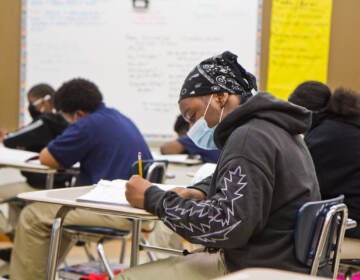Lessons from teachers — Learning through digital stories, small moments
When Robert Rivera-Amezola first considered crafting a digital stories lesson for his 4th grade students at Willard Elementary, he had only three Macintosh computers in his classroom and no knowledge of the applications to create such projects.
As a result of the big changes underway in the School District, teachers will soon be given more freedom to be creative. As part one of five part series, the Notebook and NewsWorks took a multimedia look inside the classrooms of exemplary Philadelphia teachers to get an on-the-ground perspectives of great teaching.
When Robert Rivera-Amezola first considered crafting a digital stories lesson for his 4th grade students at Willard Elementary, he had only three Macintosh computers in his classroom and no knowledge of the applications to create such projects.
But Rivera-Amezola, who has been teaching at Willard since 2001, was determined to make digital storytelling a part of the writing curriculum. So, he taught himself how to use audio and video editing programs like Garage Band and iMovie so that he could teach his students. He borrowed an idea from educator Lucy Calkins on how to get students to stretch “small moments” into complete narratives. Then, he had students turn stories in their journals into digital productions.
To Rivera-Amezola it seemed like an out-of-the box approach, but it meshed with the District’s language arts standards.
“There is an expectation that students are able to convey their message in appropriate volume, use complete sentences, pronounce words correctly, and pace their speech in a way that is decipherable,” said Rivera-Amezola.
“They are able to do these things when they record their voices and narrate their own stories.”
He said there are many stories “we don’t know because we’re so busy teaching test prep” – tales of a student’s trip to the zoo, a favorite puppy, the corner bodega, and the meaning of Mother’s Day.
Rivera-Amezola, 44, started teaching digital storytelling in 2009 while an ELL instructor. The assignment was only given once a year. By year two, more confident in his application skills, he assigned students three digital stories. He knew it was a success when students began to ask outside of class when they would be able to do their next iMovie or podcast.
“Honoring a child’s story is a major contribution to its engagement factor because they are writing about something they are interested in and know, not something that is pushed upon them,” he said.
When the new Willard opened in 2010, Rivera-Amezola became the computer technology teacher. His classroom now has 34 new iMacs, a smart board, projector, and laptop computer. Rivera-Amezola also received help from the District when its Educational Technology Group began posting student podcasts on the website.
Still, getting to deliver this lesson more than once yearly is challenging because of PSSA preparation.
“This year I was asked by the principal to devote half my time to test-related programs. The other half, the principal allowed me to continue with the technology curriculum.”
“I want my students to know basic programs like Word, PowerPoint, and Excel. But I also like digital storytelling to communicate that it’s important my students become producers, not just consumers, contribute to knowledge, and have a voice within this vast digital world.”
WHYY is your source for fact-based, in-depth journalism and information. As a nonprofit organization, we rely on financial support from readers like you. Please give today.




